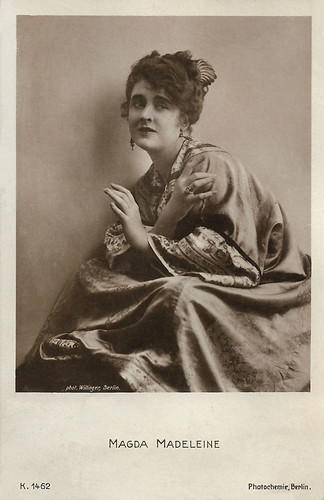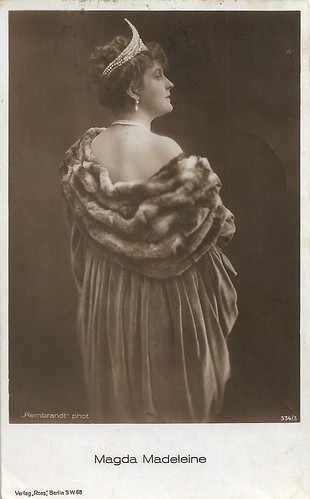
German postcard by NPG (Neue Photographische Gesellschaft), no. 910, Photo: Anny Eberth.

German postcard in the Film Sterne series by Rotophot, no. 224/2. Photo: Becker & Maass, Berlin.

German postcard in the Film-Sterne series by Rotophot, no. 224/1. Photo: Becker & Maass, Berlin.
Too young and too little respect
The actress who became known under the stage name Magda Madeleine was born in Munich in the 1890s, where she received acting lessons from Emmerich.
At the age of 16, she was discovered by producer-director Paul von Woringen (Deutsche Mutoskop & Biograph), who made her a film offer. She turned it down because she felt too young, and the medium of the film enjoyed little respect at the time.
She was "discovered" again for the film by Walter Turszinsky during a rehearsal in the Metropoltheater. At that time, she also played on other stages such as the Residenz Theatre, the Thalia Theatre, and the Wintergarten.
Magda Madeleine's film career began with the film Der Strumpf/The Stocking (Fred Sauer, 1915). At that time, she was still called Maud Madeleine, but she changed her stage name during the war to Magda Madeleine. She played mostly salon ladies and sentimental female roles, much to her dissatisfaction. In 1915-1916, she was a supporting actor in films with Ellen Richter, directed by Richard Eichberg.
In 1916 she often acted in the Stuart Webbs detective films with and by Ernst Reicher, such as Die Peitsche/The Whip (Ernst Reicher, 1916), while in 1917 she performed in the Harry Higgs detective films with Hans Mierendorff as the detective, such as Giovanni's Rache/Giovanni's revenge (Rudolf Meinert, 1917). She also played in Joe May's early film Die Hochzeit im Excentricclub/Wedding in the Eccentric Club (1917), co-scripted by Fritz Lang and starring Harry Liedtke as detective Joe Deebs.

German postcard by Photochemie, no. K. 1462. Photo: Willinger.

German postcard by Photochemie, no. K. 2169. Photo: Deutsche Mutoskop und Biograph GmbH, Berlin. Ludwig Trautmann and Magda Madeleine in Der Prozess Hauers/The Hauer trial (Willy Zeyn, 1918).

German postcard by Photochemie, no. K. 2968. Photo: Deutsche Mutoskop & Biograph GmbH, Berlin. Magda Madeleine in Die einsame Frau/The Lonely Woman (Paul von Woringen, Willy Zeyn, 1918).
Her own film series for Deutsche Mutoskop & Biograph
From late 1917, Magda Madeleine steadily worked for Deutsche Mutoskop & Biograph, where she debuted in Das Licht in der Nacht/The light in the night (Emil Albes, 1917), and continuously had leads in her own film series with films directed first mostly by Willy Zeyn, such as Der Prozeß Hauers/The Hauer trial (Willy Zeyn Sr., 1918) with Ludwig Trautmann and Rudolf Lettinger.
Later on, she appeared mostly in films by Paul Von Woringen, such as Die einsame Frau/The Lonely Woman (Willy Zeyn, Paul Von Woringen, 1918), Wenn Freunde zu Rivalen werden/When Friends Become Rivals (Paul Von Woringen, 1919), Die Lüge der Pia Mahren/The Lie of the Pia Mahren (Paul Von Woringen, 1919), and Das Rätsel der Unbekannten/The Mystery of the Unknown (Paul Von Woringen, 1919).
Often she was paired with actor Karl Beckersachs, and incidentally, she was also directed by Friedrich Féher and Jaap Speyer. All in all, between late 1917 and early 1920, Madeleine did some 16 films at Deutsche Mutoskop & Biograph. In 1920, Madeleine appeared under the name Magda Mohr in the role of a young woman in the premiere of the stage play 'Reigen' (La Ronde) by Arthur Schnitzler.
From 1920, Madeline continued to act in various films but not in leads anymore, apart from important roles in Der Mord ohne Täter/The Murder Without a Perpetrator (E.A. Dupont, 1921), Die Gebieterin von Saint Tropez/The Mistress of Saint Tropez (Franz Hofer, 1921), and Im Schatten der Anderen/In the Shadow of the Others (Von Woringen, 1924).
Madeleine's last film part was in Der Schrei nach Glück/The cry for happiness (1925) by Franz Hofer, with whom she had previously done other films as well. After that film, nothing more about Magda Madeleine is known.

German postcard by Ross Verlag, Berlin, no. 334/1, 1919-1924. Photo: Rembrandt.

German postcard by Ross Verlag, Berlin, no. 334/3, 1919-1924. Photo: Rembrandt.
Sources: Wikipedia (German) and IMDb.
This post was last updated on 21 April 2025.
No comments:
Post a Comment